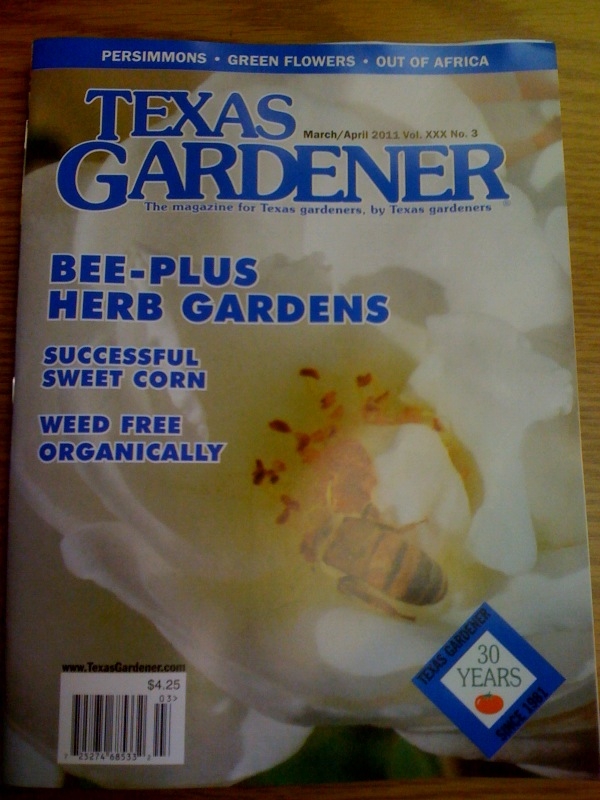 For weeks now the thought of fresh tomatoes, beans, cucumbers and okra, home-grown and sun-drenched, has been dancing across my consciousness. It’s a form of visualization that I just can’t escape this time of year and it is what drives me to dig, plant, weed, water and sweat. I’m sure you are experiencing similar spring fever symptoms!
For weeks now the thought of fresh tomatoes, beans, cucumbers and okra, home-grown and sun-drenched, has been dancing across my consciousness. It’s a form of visualization that I just can’t escape this time of year and it is what drives me to dig, plant, weed, water and sweat. I’m sure you are experiencing similar spring fever symptoms!

Here in Central Texas we may well have even experienced our last freeze (?!?) but Easter, which falls on April 16th this year, seems to be a magnet for cold weather so pay attention to the forecast in case Mother Nature decides to throw us a curve ball. Be prepared to protect or replant if damaging weather ensues. Even if we don’t get another freeze this month our young and tender transplants are vulnerable to strong winds, hail and heavy rains.

Fortunately the mild days of March are easy on both garden and gardener. Our goal in the spring vegetable garden is to plant as early as possible so we can harvest as early as possible, not so much for bragging rights (wait, this is Texas so that’s not entirely true!) but rather to avoid the misery of insects, disease and stress that comes with summer’s blistering heat. It’s hard to imagine such torment during these premiere gardening days, but it will come.
Below are six tips to help get your vegetable garden off to a good start:

Harvest and remove cool season crops. As cool weather crops reach maturity go ahead and harvest and enjoy; leaving them to grow past their prime as the weather gets hotter will only invite pests and disease. The exception, of course, is if you are growing to save seed (more on saving lettuce seed in a future post).

Grow vertical. If you have limited garden space consider growing up instead of out. Pole beans, cucumbers and small-fruited melons or winter squash can be trained to grow on an A-frame, a trellis or other vertical structure. Every couple of years I rotate vining morning glories or moonflowers on my trellises to give the soil a break from growing vegetables.

Plant into moist soil. Seeds need moisture to germinate; if it hasn’t rained in your neck of the woods then water the area where you will be planting. Really let the water soak in and saturate the soil. The same goes for transplants, water the transplant and the hole before planting. If, on the other hand, it has rained where you live allow the soil to dry out slightly before you start planting. Working wet soil can damage the structure and form long-lasting clods. Pick up a handful of soil and squeeze it into a ball then drop it onto the ground. If it breaks apart it is ok to dig but if it stays in a muddy wad it’s best to let it dry out a little longer.

Keep up with weeds. Warm, sunny days coupled with spring rains encourage weeds seeds to sprout and quickly get out of hand. They will greedily suck up any water and nutrients you provide for your vegetables. Invest in a long-handled weeder to dispatch weed seedlings in and around the garden. Above all – don’t let them go to seed. Even if weeds are not growing in the garden their seeds can blow in and they can also provide refuge for damaging pests.

Plant some flowers. Plant now and you will provide habitat and attractive blooms for beneficial insects and pollinators as the season progresses.

Keep records. It’s a good idea to keep a simple diagram of your garden plot which will help as you rotate your crop families from year to year. I like to also make note of varieties, planting dates and days to harvest so I can gauge growth during the season and keep track of productive or tasty varieties for next year’s garden. The Texas Gardener Planning Guide & Calendar pictured above is a great resource – I’ve been using it for years: https://www.texasgardener.com/Store/Products/viewproduct.aspx?id=56.
Last of all (and note to self), show a little restraint. It’s extremely easy to be enticed by warm sunshine, the smell of fresh dirt and the expectation held within tiny seeds, but as everything grows so does the time required to water, weed, scout for pests, harvest, prepare and preserve. Stick with the vegetables that will yield the most satisfaction and dining enjoyment for you and your family and go forth and have a great gardening season!
I share my posts on The Simple Homestead Blog Hop. Be sure to stop by and check out all the amazing things these gardeners and homesteaders are doing!














